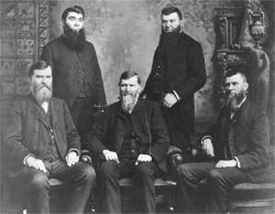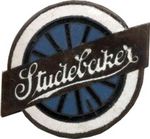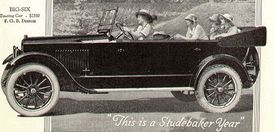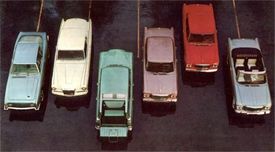.
Studebaker
Search By ModelError creating thumbnail: Unable to save thumbnail to destination
|
| Defunct |
Studebaker Corporation, or simply Studebaker, was a United States wagon and automobile manufacturer based in South Bend, Indiana. Originally the company was a producer of wagons in 1852 and was first incorporated in 1868<ref>[1]</ref> under the name of the Studebaker Brothers Manufacturing Company. While Studebaker entered the automotive business in 1902 with electric vehicles and 1904 with gasoline vehicles, it partnered with other builders of gasoline-powered vehicles until 1911. In 1913, Studebaker introduced the first gasoline-powered automobiles under its own “Studebaker” brand name. Acquired in 1954 by Packard Motors Company of Detroit, Michigan, Studebaker became a division of the Studebaker Packard Corporation from 1954 to 1962. In 1962 it reverted to its previous name, the Studebaker Corporation. While the company left the automobile business in 1966, Studebaker survived as an independent closed investment firm until 1967 when it merged with Worthington to become Studebaker-Worthington Corp.
History
19th century wagonmaker
Henry Studebaker was a farmer, blacksmith, and wagon-maker who lived near Gettysburg, Pennsylvania in the early 19th century. By 1840 he had moved to Ohio and taught his five sons to make wagons. They all went into that business as they grew westward with the country. Clement and Henry, Jr. became blacksmiths and foundrymen in South Bend, Indiana. They first made metal parts for freight wagons and later expanded into the manufacture of wagons. John made wheelbarrows in Placerville, California and Peter made wagons in Saint Joseph, Missouri. The site of John's business is California Historic Landmark #142. The first major expansion in their business came from their being in place to meet the needs of the California Gold Rush in 1849.
When the gold rush settled down, John returned to Indiana and bought out Henry's share of the business. They brought in their youngest brother Jacob and incorporated in 1852. Expansion continued to support westward migration, but the next major increase came from supplying wagons for the Union Army in the American Civil War. After the war they reviewed what they had accomplished and set a direction for the company.
They reorganized into the Studebaker Brothers Manufacturing Company in 1868, built around the motto of "Always give more than you promise." By this time the railroad and steamship companies had become the big freight movers in the east. So they set their sights on supplying individuals and farmers the ability to move themselves and their goods. Peter's business became a branch operation.
During the height of westward migration and wagon train pioneering, half of the wagons were Studebakers. They made about a quarter of them, and manufactured the metal fittings to sell to other builders in Missouri for another quarter.
Studebaker Automobiles 1897-1966
Studebaker experimented with powered vehicles as early as 1897, choosing electric over gasoline engines. While it attempted to manufacture its own electric vehicles from 1902 to 1912, the company entered into a distribution agreement with two manufactures of gasoline powered vehicles, Garford of Elyria, Ohio and the Everett-Metzger-Flanders (E-M-F) Company of Detroit.
Under the agreement with Studebaker, Garford would receive completed chassis and drivetrains from Ohio and then mate them with Studebaker built bodies which were sold under the Studebaker-Garford brand name, and at a premium price. Eventually, even the Garford built engines began to carry the Studebaker name. However Garford also built a limited number of cars under its own name, and by 1907 attempted to increase their production at the expense of Studebaker. Once Studebaker discovered what was going on with their partner, John Moehler Studebaker enforced their primacy clause, forcing Garford back onto the scheduled production quotas. The decision to drop the Garford was made and the final product rolled off of the assembly line by 1911, leaving Garford to try it alone until it was acquired by John North Willys in 1913.
Studebaker's marketing agreement with E-M-F was a different relationship, one that John Studebaker had hoped would give Studebaker a quality product, without the entanglements found in the Garford relationship. Unfortunately, this was not to be the case.
Under the terms of the agreement, E-M-F would manufacture vehicles and the Studebakers would distribute them through their wagon dealers. Problems with E-M-F made the cars unreliable leading the public to say that E-M-F stood for "Every Morning Fix-it". Compounding the problems was the internal fighting between E-M-F's principle partners, Mr. Everett, Mr. Flanders and Mr. Metzger. Eventually two-thirds of the trio left, leaving the bombastic Mr. Metzger to run the operation on his own. J.M. Studebaker, unhappy with E-M-F's poor quality, gained control of the assets and plant facilities in 1910. To remedy the damage done by E-M-F, Studebaker paid mechanics to visit each unsatisfied owner and replace the defective parts in their vehicles at a cost of to the company of US$1 million.
Studebaker also began putting its name on new automobiles produced at the former E-M-F facilities, both as an assurance that the vehicles were well-built, and as its commitment to making automobile production and sales a success. In 1911 the company reorganized as the Studebaker Corporation.
In addition to cars, Studebaker also added a truck line, which in time, replaced the horse drawn wagon business started in 1852. In 1926, Studebaker became the first automobile manufacturer in the United States to open a controlled outdoor proving ground; in 1937 the company planted 5,000 pine trees in a pattern that when viewed from the air spelled "STUDEBAKER."
From the 1920s to the 1960s, the South Bend company originated many style and engineering milestones, including the classic 1929-1932 Studebaker President and the 1939 Studebaker Champion. During World War II Studebaker produced the Studebaker US6 truck in great quantity and the unique M29 Weasel cargo and personnel carrier. After the cessation of hostilities Studebaker returned to building automobiles that appealed to average Americans and their need for transportation and mobility.
However, ballooning labor costs (the company had never had an official United Auto Workers (UAW) strike and Studebaker workers and retirees were among the highest paid in the industry), quality control issues and the new car sales war between Ford and General Motors in the early 1950s wreaked havoc on Studebaker's balance sheet. Professional financial managers stressed short term earnings rather than long term vision. There was enough momentum to keep going for another ten years, but stiff competition and price cutting by the Big Three doomed the enterprise.
Merger with Packard
Hoping to stem the tide of losses and bolster its market position, Studebaker allowed itself to be acquired by Packard Motor Car Company of Detroit; the merged entity was called the Studebaker-Packard Corporation. Studebaker's cash position was far worse than it led Packard to believe and in 1956 the nearly bankrupt automaker brought in a management team from aircraft maker Curtiss-Wright to help get it back on its feet. At the behest of C-W's president Roy T. Hurley, the company became the American importer for Mercedes-Benz, Auto Union and DKW automobiles and many Studebaker dealers sold those brands as well. In 1958, the Packard name was discontinued, although the company continued to bear the Studebaker-Packard name through 1962.
With an abundance of tax credits in hand from the years of financial losses, at the insistence of the company's banks and some members of the board of directors, Studebaker-Packard began diversifying away from automobiles in the late 1950s. While this was good for the corporate bottom line, it virtually guaranteed there would be little spending on Studebaker's mainstay products, its automobiles.
The automobiles which came after the diversification process began, including the ingeniously-designed compact Lark (1959) and even the Avanti sports car (1963) were based on old chassis and engine designs. The Lark, in particular, was based on existing parts to the degree that it even utilized the central body section of the company's 1953 cars, but was a clever enough design to be quite popular in its first year, selling over 150,000 units and delivering an unexpected $28 million profit to the automaker.
Exit of auto business
Sadly, everything that was tried in the years following the Lark's debut proved to be not enough to stop the financial bleeding. The company closed its operations in South Bend in December 1963, selling its Avanti brand to Nate Altman who continued to produce the car in South Bend under the brand name Avanti II. Automotive production was consolidated at the company's last remaining production facility in Hamilton, Ontario, Canada, where Studebaker produced cars until April, 1966, when it left the automobile business to focus on its profitable wholly owned subsidiaries. The last car manufactured was a turquoise-and-white Cruiser four-door sedan.
Many of Studebaker's dealers converted to Mercedes-Benz dealerships following the closure of the Canadian plant.
Studebaker's proving grounds were acquired by its former supplier Bendix Corporation, which later donated the grounds for use as a park to the St. Joseph County, Indiana parks department. As a condition of the donation, the new park was named Bendix Woods. The grove of 5,000 trees planted in 1937 that spelled out the company name still stand, and are known locally as the "Studebaker Trees" [2]. Today, the former proving ground is owned by Robert Bosch GmbH, and it continues to be active some 80 years after it was first built. Its General Products Division, which handled defense contracts, was acquired by Kaiser Industries, and continues to this day as AM General.
After 1966, Studebaker continued to exist as a closed investment group, with income derived from its numerous diversified units including STP, Gravely Tractor, Onan Electric Generators, and Clarke Floor Machine. Studebaker was acquired by Wagner Electric in 1967. Subsequently, Studebaker was then merged with the Worthington Corporation to form Studebaker-Worthington. The Studebaker name disappeared from the American business scene in 1979 when McGraw-Edison acquired Studebaker-Worthington. McGraw-Edison, was itself purchased in 1985 by Cooper Industries, which sold off all its auto-parts divisions to Federal-Mogul some years later.
Revival attempts
In 2003 the owners of the Studebaker XUV trademark, Avanti Motor Corporation, now based in Villa Rica, Georgia, announced a Studebaker-branded SUV, the XUV, for production that fall, bringing a demonstration model to the Chicago Auto Show. General Motors sued, claiming infringement of the trade dress of their Hummer model. In 2004 both parties announced a settlement after a redesign of the XUV concept, but owner Michael Kelly decided to retire, announcing an auction of the Avanti company. Whether there were bidders or a sale had not been made public and there were no further public announcements made regarding any such sale. However, it appears that Avanti is currently producing vehicles again, as Avanti Motors recently announced that its 2006 model-year vehicles are now available. The company notes a very limited run of 150 vehicles per year.
The XUV has been joined for 2006 by the Studebaker XUT, a pickup version that is similar in concept to the Chevrolet Avalanche, although it is not known if the XUT has the same type of "mid-gate" that allows the expansion of the cargo area into the passenger cabin.
Products
Studebaker automobile models
- Studebaker Electric (1902-1912)
- Studebaker Big Six (1918-1927)
- Studebaker Special Six (1918-1927)
- Studebaker Light Six (includes Standard Six model) (1918-1927)
- Studebaker Light Four (1918-1920)
- Studebaker President (1927-42) (1955-58)
- Studebaker Dictator (1928-36)
- Studebaker Champion (1939-58)
- Studebaker Land Cruiser (1947-54)
- Studebaker Scotsman (1957-58)
- Studebaker Commander (1928-35) (1937-58) (1964-66)
- Studebaker Conestoga (1954-55)
- Studebaker Speedster (1955)
- Hawk series:
- Studebaker Golden Hawk (1956-58)
- Studebaker Silver Hawk (1957-59)
- Studebaker Sky Hawk (1956)
- Studebaker Flight Hawk (1956)
- Studebaker Power Hawk (1956)
- Studebaker Hawk (1960-61)
- Studebaker Gran Turismo Hawk (1962-64)
- Studebaker Lark (1959-1966) (Includes Cruiser, Daytona and Lark based Commander)
- Studebaker Wagonaire (1963-66)
- Studebaker Avanti (1963-64)
Studebaker trucks
- Studebaker Coupe Express (1937-1939)
- Studebaker US6 (1941-45)
- Studebaker M29 Weasel (1942-45)
- Studebaker Transtar (1959-1963)
- Studebaker Champ (1960-1964)
Studebaker body styles
- Studebaker Starlight (1947-55, 1958)
- Starliner
- Coupe Express
Affiliated automobile marques
- E-M-F Independent auto manufacturer that marketed cars through Studebaker wagon dealers 1909-1912
- Erskine (automobile) Brand of automobile produced by Studebaker
- Packard 1954 merger partner of Studebaker
- Pierce-Arrow Acquired by Studebaker in the late 1920s
- Rockne Brand of automobile produced by Studebaker in the early 1930's
- Mercedes-Benz Distributed through Studebaker dealers 1958-1966
- Studebaker-Garford, Studebaker-bodied cars
- Tincher An early independent builder of luxury cars financed by Studebaker investment
See Also
External Links
- The Studebaker Museum
- The Studebaker Drivers Club
- Studebaker History & Photo's
- The Avanti
- Studebaker-Worthington Leasing - a corporate descendant of the historical car company
- Avanti Motor Corporation
- Gallery of Studebaker Advertisements




